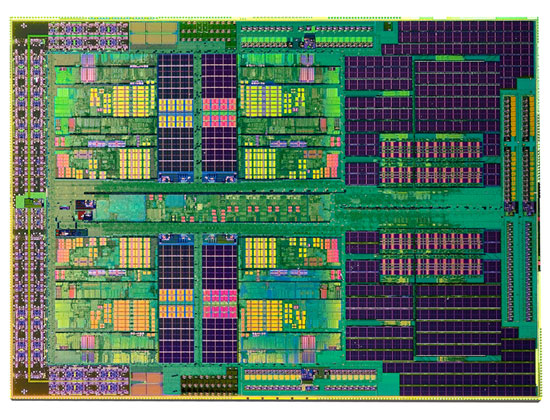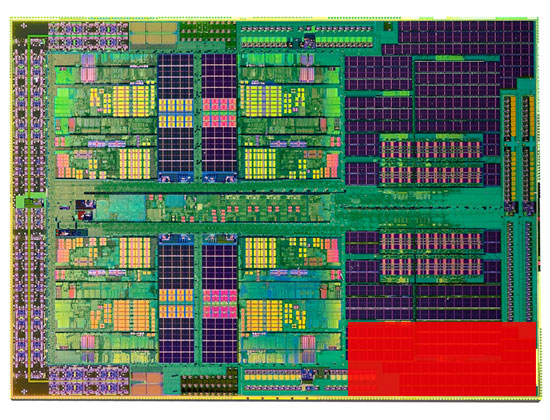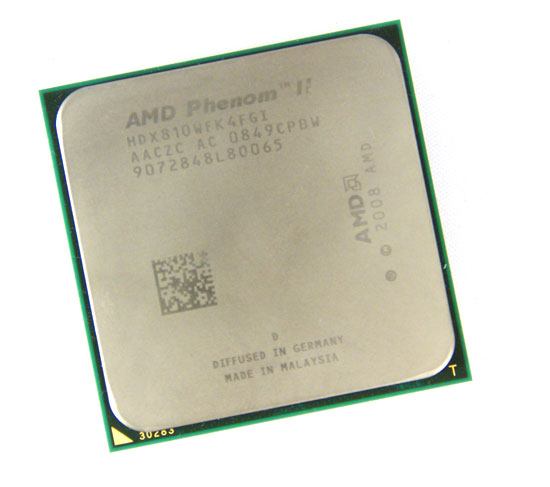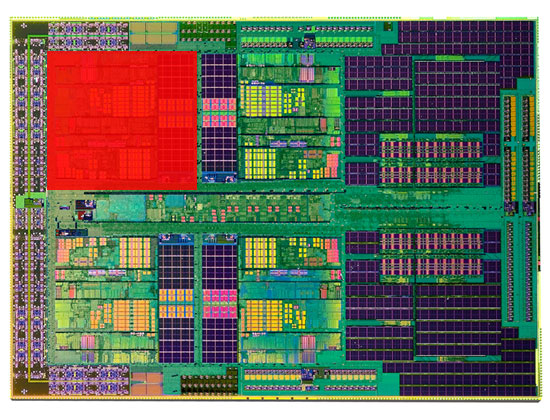The Phenom II X4 810 & X3 720: AMD Gets DDR3 But Doesn't Need It
by Anand Lal Shimpi on February 9, 2009 12:00 AM EST- Posted in
- CPUs
We're in the midst of a price war folks, and at a time when the global economy is looking a little shaky this actually works very well for us. Let's recap what's happened.
AMD launched its first truly competitive CPUs in over two years in January: the Phenom II X4 940 and 920. Priced at $275 and $235 respectively, these two chips beat out the equivalently priced Intel CPUs, the Q9400 and the Q8200. If you haven't already, I would strongly suggest reading that article in order to get the background information necessary about what was changed in Phenom II to make it so competitive.
Less than two weeks later Intel responded by cutting its quad core prices. The table below shows what happened:
| Processor | Dec '08 Price | Jan '09 Price | % Decrease |
| Intel Core 2 Quad Q9650 (3.00GHz) | $530 | $316 | 40% |
| Intel Core 2 Quad Q9550 (2.83GHz) | $316 | $266 | 16% |
| Intel Core 2 Quad Q9400 (2.66GHz) | $266 | $213 | 20% |
| Intel Core 2 Quad Q8300 (2.50GHz) | $224 | $183 | 18% |
| Intel Core 2 Quad Q8200 (2.33GHz) | $193 | $163 | 16% |
AMD responded immediately, cutting its Phenom II prices to match:
| Processor | Launch Price | New Price | % Decrease |
| AMD Phenom II X4 940 (3.0GHz) | $275 | $225 | 18% |
| AMD Phenom II X4 920 (2.8GHz) | $235 | $195 | 17% |
We really have to applaud both companies here. Intel for responding so quickly and effectively; the 40% price drop on the Q9650 just made sense and now you can have a chip with 12MB of L2 cache for under $300 thanks to the Q9550. And we have to thank AMD for keeping the pressure on and making this possible.
The Phenom II X4 940 is once more priced similar to the Core 2 Quad Q9400, while the 920 is sort of in between a Q8300 and a Q9400. Based on last month's article we know that the Phenom II X4 940 is a better buy than the Core 2 Quad Q9400, but the 920 is a tougher sell compared to the Q8300/Q9400.
Phenom II: Now in Three Flavors
Things get more complicated with today's announcement; AMD is launching no less than five new Phenom II CPUs. Their specs and model numbers are below:
| Processor | Clock Speed | un-core Clock | L2 Cache | L3 Cache | TDP | Price |
| AMD Phenom II X4 940 | 3.0GHz | 1.8GHz | 2MB | 6MB | 125W | $225 |
| AMD Phenom II X4 920 | 2.8GHz | 1.8GHz | 2MB | 6MB | 125W | $195 |
| AMD Phenom II X4 910 | 2.6GHz | 2.0GHz | 2MB | 6MB | 95W | $??? |
| AMD Phenom II X4 810 | 2.6GHz | 2.0GHz | 2MB | 4MB | 95W | $175 |
| AMD Phenom II X4 805 | 2.5GHz | 2.0GHz | 2MB | 4MB | 95W | $??? |
| AMD Phenom II X3 720 BE | 2.8GHz | 2.0GHz | 1.5MB | 6MB | 95W | $145 |
| AMD Phenom II X3 710 | 2.6GHz | 2.0GHz | 1.5MB | 6MB | 95W | $??? |
| AMD Phenom 9950 | 2.6GHz | 2.0GHz | 2MB | 2MB | 140W | $173 |
The Phenom II X4 910 is just a lower clocked version of the CPUs we reviewed last month. The 800 series is a bit more unique, albeit not in a good way. The 900 series all have 2MB of L2 cache on die and a 6MB L3; the 800 shrinks the L3 down to 4MB. If you remember back to our original Phenom II article I argued that a big reason for the original Phenom's failure was that it didn't have a large-enough L3 cache. With a 6MB L3 the 900 series seemed like a good balance between L2 and L3 cache size, but going any smaller than 6MB could prove to be overly detrimental to performance. Also keep in mind that Intel's Ronak Singhal was adament that Nehalem shouldn't have any less than an 8MB L3 (or 2MB per core), even the mainstream Core i7 derivatives are slated to have 2MB of L3 cache per core (4MB for the dual-core versions).

A Phenom II X4 900 series die: 258mm2, 4-cores and a 6MB L3 cache
The 800 series is simply an example of die harvesting. Some of the die have too many defects in the L3 cache, but fully functional cores. Instead of throwing away these CPUs AMD turns them into the Phenom II X4 800 series. While physically the same die size and transistor count of the 900 series, these chips simply have some of the L3 cache disabled:

A Phenom II X4 800 series die: 258mm2, 4-cores and a 4MB L3 cache

We've also got the Phenom II X3 720 and 710. These are both triple-core derivatives, once again they are physically the same die as the Phenom II X4 900 series, but this time with only 3 cores enabled. These are further harvested parts used simply to improve yields. I suspect that between the Phenom II 900, 800 and 700 series AMD is able to use as much of a single wafer as possible, all through harvesting and by targeting different price points. Note that this is a smart strategy to compete with Intel because Intel's 45nm yields are already quite mature, thanks to a year-long head start.

A Phenom II X3 700 series die: 258mm2, 3-cores and a 6MB L3 cache
As yields improve over time you can expect some of these parts to go away. But for now, AMD basically has a single Phenom II die that it's selling three different ways.
The 700 series is arguably one of the best harvested Phenom II parts AMD has since it retains the 6MB L3 cache of the 900 series. With 2MB of L3 cache per core, this bests even the 900 series.
When AMD produces a Phenom II die if part of the L3 is bad, it gets disabled and is sold as an 800 series chip. If one of the cores is bad, it gets disabled and is sold as a 700 series chip. If everything is in working order, then we've got a 900.










77 Comments
View All Comments
7Enigma - Monday, February 9, 2009 - link
Ditto the power consumption at OC'd levels. I always get annoyed to see these fantastic OC results but then fail to see whether we've doubled the power consumption. It would certainly allow us to see a potential benefit if one or the other uses significantly less power under OC load conditions.Gary Key - Monday, February 9, 2009 - link
We will have power consumption and temps up tomorrow for the OC results along with a few benchmarks. It was difficult to get stable (true) volt readings with the X4 810 installed, so I spent my weekend with the DMM on the boards.Kaleid - Monday, February 9, 2009 - link
Great! Possible to also add difference with non-overclocked and overclocked power consumption at idle?7Enigma - Monday, February 9, 2009 - link
At the wall (total system) or just for the CPU? Do you mean the total system power was fluctuating with the 810? That seems really really wierd.Gary Key - Monday, February 9, 2009 - link
The power was fluctuating on the board at the Core VID side. I should have a BIOS spin tonight to fix it. The 720 was perfect but the 810 had a few problems that have been identified now.7Enigma - Monday, February 9, 2009 - link
*weird, please give us an edit function.OCedHrt - Monday, February 9, 2009 - link
Interestingly, the 810 vs 910, there is no real performance difference outside the margin of error. In some cases, the 810 is faster and in some, the 910 takes the lead. Something I noticed though is that the 810 is faster than the 910 at more times, and faster by a larger amount (~3% when it is faster) as well. Seems like the reduced cache does not actually hamper performance.Moorbo - Friday, April 24, 2009 - link
For most applications it seems you're correct that the smaller cache makes little difference. However if you look at the gaming performance the 2MB/core L3 cache of the 720 and 710 clearly makes a big difference despite their slower clock and lack of an additional core. What would the numbers look like with only two cores and 3MB/core and a higher clock?johnsonx - Monday, February 9, 2009 - link
indeed, the 710 is also often faster than the 910, but usually slower than the 810.I'm a bit surprised we the readers have to thumb through all the benchmark charts to see the 710/810/910 comparison. 3 Phenom II's at the same speed, one 'standard', one with less cache and one with a missing core; that is something AT should have dedicated a page to.
stmok - Monday, February 9, 2009 - link
Yeah, I noticed that as well. It looks like 4MB L3 cache is sufficient with Phenom II. (Any less, it'll start hurting...Any more, you're just wasting silicon space).